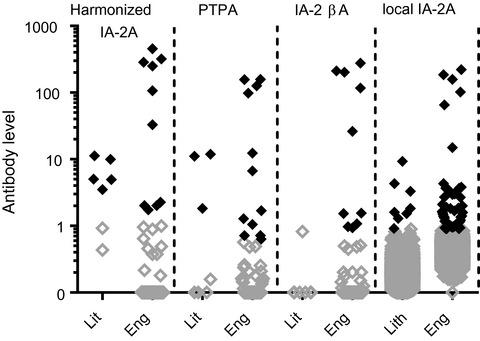当前位置:
X-MOL 学术
›
Clin. Exp. Immunol.
›
论文详情
Our official English website, www.x-mol.net, welcomes your
feedback! (Note: you will need to create a separate account there.)
Islet autoantibody profiles associated with higher diabetes risk in Lithuanian compared with English schoolchildren
Clinical & Experimental Immunology ( IF 3.4 ) Pub Date : 2020-09-26 , DOI: 10.1111/cei.13524 A E Long 1 , C H Caygill 1 , K M Gillespie 1 , D Marčiulionytė 2 , A J K Williams 1
Clinical & Experimental Immunology ( IF 3.4 ) Pub Date : 2020-09-26 , DOI: 10.1111/cei.13524 A E Long 1 , C H Caygill 1 , K M Gillespie 1 , D Marčiulionytė 2 , A J K Williams 1
Affiliation

|
During a 15‐year period, the incidence of type 1 diabetes has doubled in Lithuania, while increasing by a third in England; however, England still has a higher incidence. Analysis of sera collected from non‐diabetic schoolchildren from Lithuania and England more than 20 years ago showed a similar number of multiple autoantibody‐positive schoolchildren between the populations, but a higher prevalence of islet antigen‐2 autoantibodies (IA‐2A) in English schoolchildren. We aimed to use recently developed, more specific islet autoantibody tests to characterize differences in humoral autoimmunity between these two general population cohorts in greater detail. Samples from 88 Lithuanian and 133 English schoolchildren previously found islet autoantibody‐positive were selected for measurement of additional islet autoantibodies by radioimmunoassay. Samples were tested for autoantibodies to zinc transporter 8 (ZnT8A), GAD (96–585), the protein tyrosine phosphatase region of islet antigen‐2 (PTPA) and the related IA‐2βA, while autoantibodies to IA‐2A were reassayed using the current harmonized method. IA‐2‐related autoantibodies PTPA (0·13 versus 0·45%, P = 0·027) and IA‐2βA (0 versus 0·35%, P < 0·001), but not IA‐2A measured using the harmonized method, were less common in Lithuanian compared to English schoolchildren. Lithuanian schoolchildren who were islet autoantibody‐positive were positive for fewer biochemical autoantibodies compared with English schoolchildren (P = 0·043). Background rates of islet autoimmunity in childhood differ subtly between countries, which have different incidences of type 1 diabetes. The optimal screening strategy (age and combination of markers) for detection of islet autoimmunity may vary between countries, dependent upon the pattern of autoantibodies found in the general population.
中文翻译:

与英语小学生相比,立陶宛人的胰岛自身抗体谱与较高的糖尿病风险相关
在15年的时间里,立陶宛1型糖尿病的发病率增加了一倍,而英格兰则上升了三分之一。但是,英格兰的发病率仍然较高。对20多年前从立陶宛和英格兰的非糖尿病学童中收集的血清进行的分析显示,在人群之间,多个自身抗体阳性学童的数量相似,但在英国学龄儿童中,胰岛抗原2自身抗体(IA-2A)的患病率较高。我们旨在使用最近开发的,更具体的胰岛自身抗体测试来更详细地描述这两个普通人群之间的体液自身免疫差异。选择放射免疫法测定88名立陶宛人和133名英国学龄前儿童的样本,这些儿童先前发现了胰岛自身抗体阳性。测试了样品对锌转运蛋白8(ZnT8A),GAD(96–585),胰岛抗原2的蛋白质酪氨酸磷酸酶区域(PTPA)和相关的IA-2βA的自身抗体,而对IA-2A的自身抗体则使用当前的统一方法。IA-2相关自身抗体PTPA(0·13相对于0·45%,P = 0·027)和IA-2βA(0相对于0·35%,P <0·001),但不是使用统一方法测量的IA-2A,与英语相比,立陶宛语的使用率较低小学生。胰岛自身抗体阳性的立陶宛学童与英国学龄儿童相比,生化自身抗体阳性的比例较低(P = 0·043)。不同国家之间儿童期胰岛自身免疫的背景发生率存在细微差异,这些国家的1型糖尿病发病率也不同。用于检测胰岛自身免疫的最佳筛选策略(年龄和标记组合)可能会因国家/地区而异,具体取决于一般人群中自身抗体的模式。
更新日期:2020-09-26
中文翻译:

与英语小学生相比,立陶宛人的胰岛自身抗体谱与较高的糖尿病风险相关
在15年的时间里,立陶宛1型糖尿病的发病率增加了一倍,而英格兰则上升了三分之一。但是,英格兰的发病率仍然较高。对20多年前从立陶宛和英格兰的非糖尿病学童中收集的血清进行的分析显示,在人群之间,多个自身抗体阳性学童的数量相似,但在英国学龄儿童中,胰岛抗原2自身抗体(IA-2A)的患病率较高。我们旨在使用最近开发的,更具体的胰岛自身抗体测试来更详细地描述这两个普通人群之间的体液自身免疫差异。选择放射免疫法测定88名立陶宛人和133名英国学龄前儿童的样本,这些儿童先前发现了胰岛自身抗体阳性。测试了样品对锌转运蛋白8(ZnT8A),GAD(96–585),胰岛抗原2的蛋白质酪氨酸磷酸酶区域(PTPA)和相关的IA-2βA的自身抗体,而对IA-2A的自身抗体则使用当前的统一方法。IA-2相关自身抗体PTPA(0·13相对于0·45%,P = 0·027)和IA-2βA(0相对于0·35%,P <0·001),但不是使用统一方法测量的IA-2A,与英语相比,立陶宛语的使用率较低小学生。胰岛自身抗体阳性的立陶宛学童与英国学龄儿童相比,生化自身抗体阳性的比例较低(P = 0·043)。不同国家之间儿童期胰岛自身免疫的背景发生率存在细微差异,这些国家的1型糖尿病发病率也不同。用于检测胰岛自身免疫的最佳筛选策略(年龄和标记组合)可能会因国家/地区而异,具体取决于一般人群中自身抗体的模式。











































 京公网安备 11010802027423号
京公网安备 11010802027423号